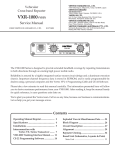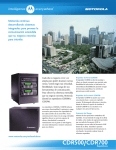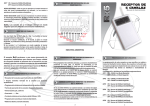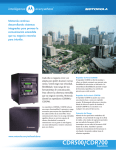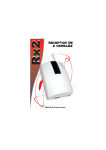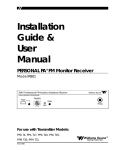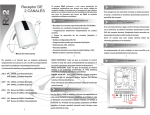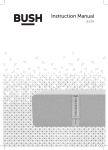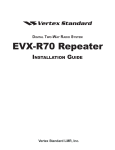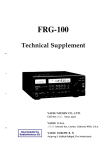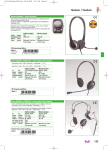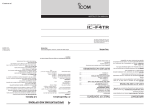Download VXR-1000 - Air Comm
Transcript
CONTROLS & CONNECTORS Front Panel VXR-1000 SPECIFICATIONS GENERAL Rear Panel Frequency Range: OPERATING MANUAL The VXR-1000 Series is designed to provide extended handheld coverage by repeating transmissions in both directions through an existing high power mobile radio. Reliability is assured by a highly integrated surface mount circuit design and a aluminum extrusion chassis. Important channel frequency data is stored in EEPROM, and is easily programmable by dealers using a personal computer and the Vertex Standard VPL-1 Programming Cable and CE-22 Software. Please take a few minutes to read this manual carefully. The information presented here will allow you to derive maximum performance from your VXR-1000. After reading it, keep the manual handy for quick reference, in case questions arise later on. We’re glad you joined the Vertex Standard team. Call on us any time, because our business is communications. Let us help you get your message across. Microphone Jack Connect the microphone plug to this jack. CHANNEL Selector Knob This knob selects the operating channel. PRI Indicator When on, “PRI” indicates that the unit is at priority count zero and will repeat all transmissions. TX Indicator When on, “TX” indicates that the repeater is transmitting to the handheld. COR Indicator This lamp blinks red when the VXR-1000 is receiving a signal from a handheld, and glows red while the VXR-1000 is receiving a sub-audible tone from the handheld. This device complies with Part 15 of the FCC rules. Operation is subject to the condition that this device does not cause harmful interference. PWR Indicator This is the main “POWER ON” indicator for the VXR-1000. VOLUME Knob This knob adjusts the receiver volume. E 1 3 3 7 7 No portion of this manual may be reproduced without the permission of Vertex Standard LMR, Inc. 5 0 3 ERROR MESSAGE No Channel Data TX, COR, and PWR indicators Blinks (Operating Channel is Vacant) ARTS Out of Range PWR indicator Blink DSUB 9-Pin Accessory Connector External TX audio line-input, PTT, external RX audio lineoutput, and other signals may be obtained from this connector for use with accessories. Pin 1 Pin 3 Pin 5 Pin 7 Pin 9 PIN A SSIGNMENT GND Pin 2 Mobile Transmit Audio Power Supply Control Pin 4 Mobile PTT Output Vcc (13.8 V DC) Pin 6 Moble Receive Audio Mobile COR Detect Pin 8 Mobile Microphone Audio Mobile TX Detect / Mobile Micophone PTT Antenna Socket The Antenna socket is a standard 50 Ω BNC antenna connector. RECEIVER Double Conversion Superheterodyne Sensitivity (EIA 12dB SINAD): 0.30 µV (VXR-1000V) 0.35 µV (VXR-1000U) 20 dB Quieting: 0.40 µV (VXR-1000V) 0.45 µV (VXR-1000U) Squelch Threshold: 0.2 µV to 2 µV Adjacent Channel Selectivity: 60 dB Intermodulation Rejection: 60 dB Spurious and Image Rejection: 60 dB Conducted Spurious Emissions: −57 dBm Audio Output: 1 W into 8 Ω w/<5% THD Hum and Noise: 40 dB Circuit Type: TRANSMITTER FUNCTIONAL DESCRIPTION When the user leaves the vehicle, they activate their mobile radio via its front panel or a separate switch. When the mobile radio is receiving a signal, the VXR-1000 will begin transmitting on the hand-held’s receive frequency. The user is able to hear and respond to all radio traffic, including other hand-helds on the same frequency. The repeater jumpers and potentiometers are custom-configured for use with the particular mobile radio to which it will be connected. The CE-22 software is used to program the repeater for the required operating parameters. HARDWARE SETTINGS TRUNKING OPERATION JP1004: Controls the output impedance of the transmit audio line to the mobile radio. Short: low-Z (600 Ω); open: high-Z (4.7 kΩ) * JP1005: Controls the maximum drive level of the transmit audio output to the mobile. Short: low level output (0-100 mV)*; open: high level output (0-5 V). JP1001/1002/1003: Polarity of Power supply control. Default setting: active high (JP1003: short). VR1001: Mobile Microphone level VR1002: Mobile RX Audio (External Modulation level) VR1007: Mobile TX Audio (output level) * default setting When the radio is connected to a trunking mobile you wish to access the system from your handheld radio, key the handheld briefly then release the PTT key. The radio will attempt to acquire a voice channel on the trunking system by keying the mobile for 200 mS and monitoring the “on-air detect” line from the mobile. If the VXR-1000 does not see the radio transmit at all (system is busy), it will send a low tone to the handheld to alert you that the system is busy. The radio will automatically retry every 5 seconds and send a “busy” tone to the handheld with each unsuccessful attempt, to indicate progress of the call attempt. If unsuccessful after 30 seconds, the radio will transmit an “intercept” tone to alert the handheld that the call attempt failed. The VXR-1000 has a fixed 3 minute time-out timer for base to handheld transmissions. If the mobile COR is active for more than 3 minutes it will send a error blip and cease transmission until the mobile COR is inactive. Vertex Standard LMR, Inc. An external loudspeaker may be connected to this 2-contact, 3.5-mm mini-phone jack. MBL Indicator This lamp blinks red when the Mobile is receiving signal from repeater or base, and glows red while the Mobile is transmitting to the repeater or base. Copyright 2013 Vertex Standard LMR, Inc. All rights reserved. EXT SP (External Speaker) Number of Channels: Channel Spacing: Supply Voltage: Ambient Temperature Range: Frequency Stability: RF Input-Output Impedance: Audio Output Impedance: Case Size (WHD): Weight: 150 - 174 MHz (VXR-1000V) 450 - 470 MHz (VXR-1000U) 16 Channels 12.5/25 kHz 13.8V DC −30 °C to +60 °C 2.5 ppm 50 Ω 8Ω 111 x 25.4 x 136 mm 400 g When the VXR-1000 detects that the mobile is transmitting, it will continue to monitor the “on-air detect” line until the transmitter remains keyed for at least 250 mS to determine if the radio is merely handshaking or retrying. After successful acquisition of a voice channel, it will continue to hold the mobile’s PTT active for 2 seconds and transmit a “go-ahead” blip to the handheld. You may then key their handheld to speak on the voice channel. If you do not key up within the 2-second period, the radio will un-key the mobile and send the “intercept” tone, as before. Power Output: Modulation: Maximum Deviation: Conducted Spurious Emissions: FM Hum and Noise: 5.0/2.5/1.0/0.5 W 16K0F3E /11K0F3E ±5 kHz/2.5 kHz 60 dBc 40 dB OPTIONAL ACCESSORIES MH-53A8J MLS-100 VPL-1 CE-22 FRB-4 T9101411 Microphone External Loudspeaker Programming Cable Programming Software (for IBM PC/compatibles only) Programming Interface Box Radio-to-Radio Cloning Connection Cable (used with the FRB-4 Programming Interface Box) WARRANTY POLICY Vertex Standard warrants, to the original purchaser only, its Vertex Standard manufactured communications products against defects in materials and workmanship under normal use and service for a given period of time from the date of purchase. Limited Warranty Details: North America customers (USA and Canada): http://www.vertexstandard.com/lmr/warranty-terms.aspx Customers outside of North America: Contact the authorized dealer in your country. NOTICE There are no user-serviceable points inside this transceiver. All service jobs must be referred to your Authorized Service Center or Network Administrator. CONTROLES Y CONECTORES MANUAL DE INSTRUCCIONES DEL Panel Delantero Panel Posterior Clavija para micrófono EXT SP (Parlante Externo) VXR-1000 La seguridad funcional está respaldada por la extraordinaria integración de los componentes del circuito y por el chasis de aluminio fundido a presión que éste posee. Los datos importantes relativos a la frecuencia de canales son almacenados en la memoria EEPROM, los cuales el distribuidor autorizado puede configurar sin ninguna dificultad con una computadora personal, el cable de programación VPL-1 y la rutina para ordenadores CE-22 de Vertex Standard. En esta clavija conecte el enchufe para micrófono. Perilla Selectora de Canales “CHANNEL” Esta perilla sirve para seleccionar el canal de trabajo que desea utilizar. PRI Cuando el icono “PRI” está iluminado, significa que la unidad está en la cuenta prioritaria cero y que por ende, va a repetir todas las transmisiones. Haga el favor de detenerse unos minutos para leer este manual con atención. La información que aqu se presenta le permitir aprovechar al máximo todas las ventajas funcionales del VXR1000. Una vez que termine de leer este manual, manténgalo a mano para consultarlo, en caso de que en el futuro surja cualquier duda relacionada con el funcionamiento de este transceptor. TX Nos complace que se haya integrado a la familia Vertex Standard. Llámenos cuando quiera, puesto que las comunicaciones son asunto nuestro y permítanos ayudarle a transmitir su mensaje. COR [relé accionado por la portadora] Este equipo ha sido fabricado de acuerdo a la Sección 15 del Reglamento de la Comisión Federal de Comunicaciones “FCC” y puede operarlo mientras no cause ningún tipo de interferencia perjudicial a otros usuarios. ADVERTENCIA No existe ninguna pieza que pueda ser reparada por el usuario dentro del transceptor. Todo trabajo de reparación debe ser atendido en el Centro de Servicio Técnico Autorizado o si no, por el Administrador de la Red a la que pertenece. ERROR MESSAGE No Channel Data TX, COR, and PWR indicators Blinks (Operating Channel is Vacant) ARTS Out of Range PWR indicator Blink Cuando el indicador de “TX” está iluminado, significa que la repetidora ha comenzado a emitir señales dirigidas al radio portátil. Esta luz se enciende de color rojo en forma intermitente cuando el VXR-1000 está recibiendo una señal proveniente de un radio portátil, pero permanece fijamente iluminada de ese mismo color cada vez que capta un tono subaudible generado por dicho aparato móvil de comunicación. MBL Esta luz se enciende de color rojo en forma intermitente apenas el Móvil recibe una señal proveniente de la estación base o repetidora, pero se ilumina fijamente de ese mismo color cuando dicho Móvil comienza a transmitir señales hacia la estación base o repetidora respectiva. PWR Éste es el indicador de “ENCENDIDO” principal que posee el transceptor VXR-1000. Perilla del VOLUMEN Esta perilla sirve para ajustar la intensidad del volumen correspondiente al receptor. REGULACIÓN DE LOS DISPOSITIVOS DE CONTROL JP1004: Controla impedancia de salida de la línea de audio de transmisión que va hacia el móvil. En cortocircuito: Z baja (600 Ω); abierto: Z alta (4.7 kΩ)* JP1005: Controla el nivel de excitación máxima de la salida de audio de transmisión hacia el móvil. En cortocircuito: salida de baja potencia (0-100 mV)*; abierto: salida de alta potencia (0-5 V). JP1001/1002/1003: Controla la polaridad de la fuente de alimentación. Valor de programación original: máximo activo (JP1003: en cortocircuito). VR1001: Nivel del Micrófono del móvil. VR1002: Audio de recepción del móvil (nivel de Modulación Externa) VR1007: Audio de transmisión del móvil (nivel de salida) * corresponde al valor de programación original El VXR-1000 posee un temporizador fijo de 3 minutos de duración para las transmisiones que se realizan desde la base hacia los equipos de comunicación portátiles. Si el COR del móvil permaneciera accionado por más de 3 minutos, el radio generará una señal de error, interrumpiendo entonces toda comunicación hasta que dicho relé sea desactivado por completo. Este minienchufe para micrófono de 3,5 mm y de 2 dos alfileres de contacto sirve para conectar un parlante externo en el transceptor. Conector para Accesorios Cuando el usuario se baja del vehículo, él activa el radio portátil a través del panel frontal o si no, mediante un interruptor de encendido independiente. En el momento en que el equipo portátil recibe una señal, el VXR-1000 comienza a transmitir por la frecuencia de recepción del móvil. El usuario puede entonces escuchar y responder a todo el tráfico de radiocomunicación, incluyendo a los demás equipos portátiles que se encuentren en la misma frecuencia. Los puentes de conexión del repetidor, al igual que los potenciómetros, también son configurados para que funcionen específicamente con el radio móvil al cual dicho aparato ha de ser conectado. La rutina de programación CE-22 se utiliza para realizar la configuración del repetidor, de modo que concuerde con los parámetros funcionales exigidos en cada caso. ESPECIFICACIONES TÉCNICAS de 9 Alfileres de Contacto “DSUB” Este conector es el que proporciona para los accesorios una línea de entrada para audio de TX externo, para el interruptor del PTT, una línea de salida para audio de RX externo y de varias otras señales también. ALFILER DE CONTACTO El transceptor de la Serie VXR-1000 está proyectado para expandir la cobertura de equipos portátiles al repetir las transmisiones en ambos sentidos a través de un radio móvil de gran potencia existente en el área. DESCRIPCIÓN FUNCIONAL 1 2 3 4 5 6 7 8 9 Asignación de los Alfileres de Contacto GND (A tierra) Audio de Transmisión del Móvil Control de la Fuente de Alimentación Salida del PTT para le Móvil Vcc (13.8 V CC) Audio de Recepción del Móvil Detección COR del Móvil Audio del Micrófono del Móvil Detector de TX del Móvil / PTT del Micrófono del Móvil Zócalo de Antena El zócalo de antena es un conector estándar, tipo BNC para 50 Ω. FUNCIONAMIENTO DEL SISTEMA DE TRONCALIZACIÓN Cuando el radio está conectado a un móvil de troncalización a cuyo sistema desea ingresar a partir de su radio portátil, usted debe conmutar brevemente dicho aparato y luego soltar el interruptor del PTT. En ese momento, el radio intentará adquirir un canal de voz en el sistema de troncalización conmutando el móvil durante 200 ms y vigilando la línea de “detección en el aire” proveniente de dicho móvil. Si el VXR-1000 no llega a distinguir ninguna trasmisión proveniente del radio (al encontrarse ocupado el sistema), éste le enviará un tono bajo al portátil con el objeto de advertirle que por el momento el sistema no está disponible. El radio en forma automática seguirá intentándolo una vez cada 5 segundos, en cuyo caso enviará un tono de “ocupación” al equipo portátil cada vez que no logre encontrar un canal, con el objeto de dar a conocer el resultado de cada uno de los intentos de llamada. Si transcurren 30 segundos sin que el radio logre establecer contacto, éste emitirá un tono de “intercepción” para indicarle al equipo portátil que todos los intentos de llamada han fracasado. Cuando el VXR-1000 detecta al móvil transmitiendo, éste continúa vigilando la línea de “detección en el aire” hasta que el transmisor permanezca activado durante 250 ms por lo menos, con el objeto de comprobar si el radio se encuentra meramente reconociendo el protocolo o realizando un nuevo intento. Una vez que logra adquirir un canal de voz, el transceptor sigue manteniendo activado el PTT del móvil durante 2 segundos más, para luego enviar la señal de “invitación a transmitir” al equipo portátil. Posteriormente, usted puede conmutar el equipo portátil remoto con el propósito de hablar por el canal de voz. Si no manipula tal equipo dentro de los 2 segundos establecidos, el radio suspenderá la conmutación del móvil y enviará el tono de “intercepción”, tal como se indicó en el caso anterior. ASPECTOR GENERALES 150 - 174 MHz (VXR-1000V) 450 - 470 MHz (VXR-1000U) Número de Canales: 16 Canales Espaciamiento de Canales: 12.5/25 kHz Tensión de Alimentación: 13.8V CC Margen de Temperatura Ambiental: de –30 °C a +60 °C Estabilidad de Frecuencia: 2.5 ppm Impedancia de entrada-salida de RF: 50 Ω Impedancia de Salida de Audio: 8 Ω Tamaño del Estuche: 111 x 25,4 x 136 mm (ancho, alto, fondo) Peso: 400 gr. Gama de Frecuencias: RECEPTOR Heterodino de Doble Conversión 0.30 µV (VXR-1000V) 0.35 µV (VXR-1000U) Silenciamiento de 20 dB: 0.40 µV (VXR-1000V) 0.45 µV (VXR-1000U) Umbral de Silenciamiento: 0.2 µV a 2 µV Selectividad de Canal Adyacente: 60 dB Rechazo a la Intermodulación: 60 dB Rechazo de Frec. Imagen y de Espurias: 60 dB Emisiones Espurias Propagadas: –57 dBm por Conducción Salida de Audio: 1 vatio en 8 Ω con una Distorsión Armónica Global de <5% Perturbaciones y Ruidos: 40 dB Tipo de Circuito: Sensibilidad (EIA 12dB SINAD): TRANSMISOR Salida de Potencia: Modulación: Desviación Máxima: Emisiones Espurias: Propagadas por Conducción Perturbaciones y Ruidos de FM: MH-53A8J MLS-100 VPL-1 CE-22 FRB-4 T9101411 5.0/2.5/1.0/0.5 vatios 16K0F3E /11K0F3E ±5 kHz/2.5 kHz 60 dBc 40 dB ACCESORIOS Micrófono Parlante Externo Cable de Programación Rutina de Programación (sólo para computadores IBM o compatibles) Caja de Conversión para Programación Cable Conector de Duplicación de Radio a Radio


